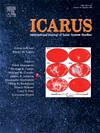The source of hydrogen in earth's building blocks
IF 2.5
2区 物理与天体物理
Q2 ASTRONOMY & ASTROPHYSICS
引用次数: 0
Abstract
Despite being pivotal to the habitability of our planet, the process by which Earth gained its present-day hydrogen budget is unclear. Due to their isotopic similarity to terrestrial rocks across a range of elements, the meteorite group that is thought to best represent Earth's building blocks is the enstatite chondrites (ECs). Because of ECs' nominally anhydrous mineralogy, these building blocks have long been presumed to have supplied negligible hydrogen to the proto-Earth. However, recent bulk compositional measurements suggest that ECs may unexpectedly contain enough hydrogen to readily explain Earth's present-day water abundance. Together, these contradictory findings mean the contribution of ECs to Earth's hydrogen budget is currently unclear. As such, it is uncertain whether appreciable hydrogen is a systematic outcome of Earth's formation. Here, we explore the amount of hydrogen in ECs as well as the phase that may carry this element using sulfur X-ray absorption near edge structure (S-XANES) spectroscopy. We find that hydrogen bonded to sulfur is prevalent throughout the meteorite, with fine matrix containing on average almost 10 times more H![]() S than chondrule mesostasis. Moreover, the concentration of the H
S than chondrule mesostasis. Moreover, the concentration of the H![]() S bond is linked to the abundance of micrometre-scale pyrrhotite (Fe1-xS, 0 < x < 0.125). This sulfide can sacrificially catalyse a reaction with H2 from the disk at high temperatures to create H2S, which could be dissolved in adjoining molten silicate-rich material. Upon rapid cooling, this assemblage would form pyrrhotite encased in submicron silicate-rich glass that carries trapped H2S. These findings indicate that hydrogen is present in ECs in higher concentrations than previously considered and could suggest that this element may have a systematic, rather than stochastic, origin on our planet.
S bond is linked to the abundance of micrometre-scale pyrrhotite (Fe1-xS, 0 < x < 0.125). This sulfide can sacrificially catalyse a reaction with H2 from the disk at high temperatures to create H2S, which could be dissolved in adjoining molten silicate-rich material. Upon rapid cooling, this assemblage would form pyrrhotite encased in submicron silicate-rich glass that carries trapped H2S. These findings indicate that hydrogen is present in ECs in higher concentrations than previously considered and could suggest that this element may have a systematic, rather than stochastic, origin on our planet.
地球建筑材料中的氢源
尽管对我们星球的宜居性至关重要,但地球获得今天氢预算的过程尚不清楚。由于它们的同位素与陆地岩石在一系列元素上的相似性,被认为最能代表地球基石的陨石群是顽辉石球粒陨石(ECs)。由于ec表面上的无水矿物学特征,长期以来,人们一直认为这些组成部分为原地球提供的氢可以忽略不计。然而,最近的体积成分测量表明,ec可能出乎意料地含有足够的氢,可以很容易地解释地球今天的水丰度。总之,这些相互矛盾的发现意味着ec对地球氢预算的贡献目前尚不清楚。因此,尚不确定可观的氢是否是地球形成的系统结果。在这里,我们利用硫x射线吸收近边结构(S-XANES)光谱研究了ECs中氢的含量以及可能携带这种元素的相。我们发现,氢与硫的结合在整个陨石中普遍存在,细粒基质中HS的平均含量几乎是球粒介稳态的10倍。此外,HS键的浓度与微米级磁黄铁矿的丰度有关(Fe1-xS, 0 <;x & lt;0.125)。这种硫化物可以在高温下牺牲性地催化磁盘上的H2反应,生成H2S, H2S可以溶解在相邻的熔融富硅酸盐物质中。在快速冷却后,这种组合将形成磁黄铁矿,磁黄铁矿包裹在亚微米富硅酸盐玻璃中,携带捕获的H2S。这些发现表明,氢在ECs中的浓度比之前认为的要高,这可能表明这种元素可能在我们的星球上有一个系统的起源,而不是随机的。
本文章由计算机程序翻译,如有差异,请以英文原文为准。
求助全文
约1分钟内获得全文
求助全文
来源期刊

Icarus
地学天文-天文与天体物理
CiteScore
6.30
自引率
18.80%
发文量
356
审稿时长
2-4 weeks
期刊介绍:
Icarus is devoted to the publication of original contributions in the field of Solar System studies. Manuscripts reporting the results of new research - observational, experimental, or theoretical - concerning the astronomy, geology, meteorology, physics, chemistry, biology, and other scientific aspects of our Solar System or extrasolar systems are welcome. The journal generally does not publish papers devoted exclusively to the Sun, the Earth, celestial mechanics, meteoritics, or astrophysics. Icarus does not publish papers that provide "improved" versions of Bode''s law, or other numerical relations, without a sound physical basis. Icarus does not publish meeting announcements or general notices. Reviews, historical papers, and manuscripts describing spacecraft instrumentation may be considered, but only with prior approval of the editor. An entire issue of the journal is occasionally devoted to a single subject, usually arising from a conference on the same topic. The language of publication is English. American or British usage is accepted, but not a mixture of these.
 求助内容:
求助内容: 应助结果提醒方式:
应助结果提醒方式:


